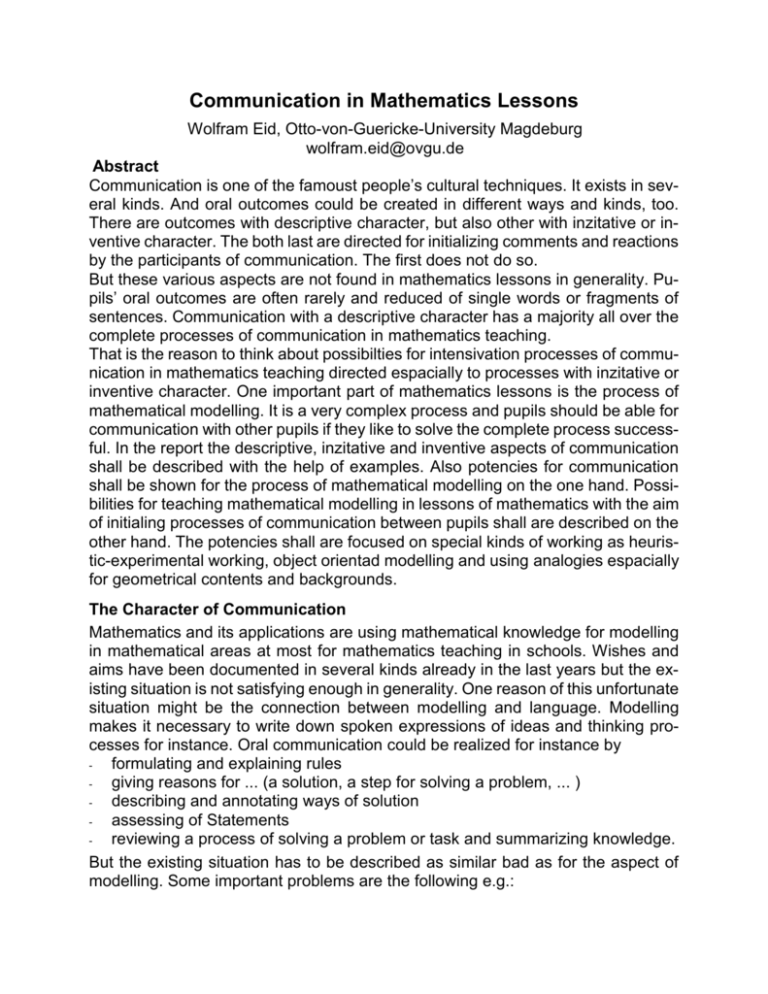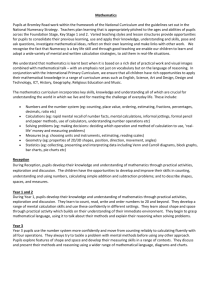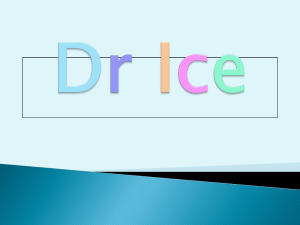EID
advertisement

Communication in Mathematics Lessons Wolfram Eid, Otto-von-Guericke-University Magdeburg wolfram.eid@ovgu.de Abstract Communication is one of the famoust people’s cultural techniques. It exists in several kinds. And oral outcomes could be created in different ways and kinds, too. There are outcomes with descriptive character, but also other with inzitative or inventive character. The both last are directed for initializing comments and reactions by the participants of communication. The first does not do so. But these various aspects are not found in mathematics lessons in generality. Pupils’ oral outcomes are often rarely and reduced of single words or fragments of sentences. Communication with a descriptive character has a majority all over the complete processes of communication in mathematics teaching. That is the reason to think about possibilties for intensivation processes of communication in mathematics teaching directed espacially to processes with inzitative or inventive character. One important part of mathematics lessons is the process of mathematical modelling. It is a very complex process and pupils should be able for communication with other pupils if they like to solve the complete process successful. In the report the descriptive, inzitative and inventive aspects of communication shall be described with the help of examples. Also potencies for communication shall be shown for the process of mathematical modelling on the one hand. Possibilities for teaching mathematical modelling in lessons of mathematics with the aim of initialing processes of communication between pupils shall are described on the other hand. The potencies shall are focused on special kinds of working as heuristic-experimental working, object orientad modelling and using analogies espacially for geometrical contents and backgrounds. The Character of Communication Mathematics and its applications are using mathematical knowledge for modelling in mathematical areas at most for mathematics teaching in schools. Wishes and aims have been documented in several kinds already in the last years but the existing situation is not satisfying enough in generality. One reason of this unfortunate situation might be the connection between modelling and language. Modelling makes it necessary to write down spoken expressions of ideas and thinking processes for instance. Oral communication could be realized for instance by formulating and explaining rules giving reasons for ... (a solution, a step for solving a problem, ... ) describing and annotating ways of solution assessing of Statements reviewing a process of solving a problem or task and summarizing knowledge. But the existing situation has to be described as similar bad as for the aspect of modelling. Some important problems are the following e.g.: Teachers call upon pupils not enough to speak loudly. Productive speaking (especially speaking in coherent sentences) is not stimulated enough. Different teaching methods are rarely as stimulant to speak. Book-tasks, which could have a benefical effect on intellectual and creative work are used only sometimes (standard-tasks are used very often). Teachers often do not give enough time for discussions of different ways or methods to get a solution of a task or of wrong solutions in their lessons. Tasks to describe mathematical facts with own words (and reverse) by pupils are very rarely. Communication media (natural language, written assembly language, drawings, pattern) are used only spontaneously. Pupils like to speak in lessons with a minimum of words. So their sentences are often not correct in the natural language and without aesthetics. Problems in notification are so programed. That is the reason to think about connections between language and modelling and to find possibilities for stimulating pupils' communication in the class-room. To do so it is necessary to make clear the subject of language. A lot of definitions are existing about this subject. Three aspects could be focussed out of all of them: Language is a system of oral or nonoral signs (the lexis) with some rules of connections between them (the grammar) and semantic contents (linguistic aspect). Language could mean also to use the instrument "language" to tell something (psychological aspect). Language also specified alienated activity of people to change information (social aspect). For teaching, especially mathematical teaching the second aspect is the most important one. It is determined by the system of the used language (natural language, mathematical language, symbols, etc.) on the one hand and by the orientation of the aim of the specified communication on the other hand. Four in their character different categories of methods for communication could be distinguished; components written in italic have an espacially significance for mathematics teaching: descriptive character inventive character giving a talk reporting summarizing explaining exposing disproving informing describing giving reasons arguing generalizing defining discovering proving drawing conclusions claiming - inzitative character wishing ordering demanding inatructing supposing asking contactive character asking greating wishing congratulating But observations in lessons of mathematics have been shown descriptive communication is the mostly used kind of communication and it seems language or communication becomes poor by reducing to single words or parts of sentences at most. (An analysis of the communication of pupils in 20 random selected lessons of mathematics has shown that near the half of all oral outcoms by pupils have a descriptive character and that near 80 % are only single words or fragments of sentences.) That is the reason for thinking about kinds of teaching stimulating non-descriptive components of language and to find out possibilities of mathematical modelling for it. A view about the complete process of mathematical modelling (compare figure 1) shows different phases in the process defined by different dominated components of communication. (In addition to the given dominating components other components have also an influence to the communication, but even a smaller one, and transitions are possible, of course). phase of mathematical application task applications (problem) phase of heuristical moments algorithms theoremes phase to reach exactness supposition terms process of mathematical modelling inwards mathematics (/1/) main component(s) of communication giving the problem descriptive components finding a way for solving the problem inzitative components the developing-algorithm-phase inzitative/inventive components the phase of reviewing descriptive components phase 1 2 3 4 Initiating Communication by Heuristic Elements In addition it is thinkable to stimulate communication between pupils with a spezified character by selecting one of the described phases above. For instance selecting the phase of heuristical moments and creating corresponding tasks for the teaching of mathematics it should be possible to stimulate communication with an inzitative character. A simple kind to do so could be an intuitive-heuristic working for solving a problem instead of solving with the help of algorithms. The difference between both kinds shall be shown with the help of a task about similar triangles below. Given the areas (in square inches) of two similar triangles (F1 = 6,4; F2 = 2,4) and the side a1 = 4 inches. Calculate the altitude h1 in this triangle and the corresponding quantities in the other triangle! Is the construction of both triangles possible by the given dates? /2/ solving about algorithmitical working as usually 2F a h 8 h1 1 , F1 F2 ' k 2 F2 k , a2 1 , h2 1 a1 3 k k solving about intuitive-heuristic working I. F1 = 6,4 sqin; a1 = 4 in F1 : F2 = 8:3 = II. III. a2 h2 a1 : a2 h1 : h2 h1 = 3,2 in F1 8 12,8 sqin F2 3 a2 h2 2 2,4 2 4:3 2 in < a2 < 3 in 2,5 ▼ a2 1 4,8 4 4,8 F2 = 2,4 sqin a 2 h 2 = 4,8 sqin 3 1,6 4:3 2 a2, h2 (1,6 in < h1 < 2,4 in) 2,4 ▲ 2,45 h2 1,92 ▲ 2 ▼ 1,96 al : a2 1,6 1,67 1,632... hi : h2 1,67 1,6 1,632... 6 , More strictly directed to the developing of faculties in heuristical thinking and car7 6 rying out inzitative dominated processes of communication by pupils is using heuristical strategies for working in mathematics lessons for instance the strategy of using analogies. Some ideas about that have been written down in /3/. Another way could be directed by the kind of working in sciences (for instance physics, chemistry) that are using the experiment to get new discoveries. One typical example to do so is the following given sequence of tasks: task 1: Reconstruct the following experiment with a calculator and give reasons for the results to see! Input Display 17,3 ° 17.3 SIN 2.9737-01 INV 2.9737-01 SIN 17. 3 task 2: What do you think about the result in the next example? Input Display 154° 154 SIN 4.3837-01 INV 4.3837-01 SIN ....... Test your supposition with the calculator and complete: sin 154° = sin ……….! task 3: Give other pairs of angles using the same sequence of steps by a calculator! task 4: Give a general supposition about a connection between data of the sinus function in the I. and II. quadrant. Last but not least teaching mathematics could be directed very strongly by the kind of working in sciences using hypothesises on the way to new discoveries. The principle idea and a practical example of that shall be shown on the following two pages. /5/ What's the angle between a cube's diagonal and its ground-area? 1. The pupils give a hypothesis after they have read the task and thought about it. „ The angel is the same in all kinds of cubes." 2. The pupils try to find some ideas to overcome the problem. Calculations in triangles are suggested about the made drawings. d a stimulating communication; Other pupils are going to think about the given hypothesis, make some drawings and so on. communication with discussions; Pupils like to give reasons for their ideas and ask the others about the correctness of their ideas, too. stimulating communication; Some pupils could have the idea to use the Pythagoras' theorem. So other pupils give their thoughts on the inputs of the task, for example Are there enough data in the task to overcome the problem in this way? 3. The pupils give statements for experimental tests. „Cubes with edges of 4 cm, 5 ft., 25 in. ... have the same angles." stimulating communication; 4. The pupils carry out the experiments. describing communication; Pupils describe their procedures for the experiments. establishing communication; Pupils establish the truth of the statements. 5. Pupils get and test a solution. The tested statements are true. The hypothesis could be so, too. 6. Generalization of the solution by means of variables. Pupils also think and speak about the used strategy. (new actions are triggered off) communication with inventive character: The pupils give general reasons for the truth of the hypothesis: tan a 2a 2 1 2 2 Demonstration-orientated versus Object-orientated Teaching The phase to reach exactness of the process of modelling is dominated by communication with inzitative or inventive character. If the teacher tries to dominate these components he should think about the kind of modelling. A view to lessons in mathematics shows a situation as follows in generality: An algorithm or a calculus has been developed or given by the teacher and after that it is used to solve series of several and different kinds of tasks (method-orientated teaching). The calculus of curve-tracing is a typical example for it. Another possibility of modelling could be the examination of one object with several methods, a more objectorientated modelling (compare the following two figures). Characteristics of mathematical object-orientated modelling shown at he example of geometrical objects (compare also /4/) description with developing new methods of mathematical the aim the help of modelling getting to know new well-known and unknown (geometrical) objects methods using new methods of (single objects or ma-thematical modelclasses of obling to get to know jects) more about new objects symmetrical examining transforming and completing zooming filling up working with coordinates (exhaustionsmethod) The idea of this kind of modelling shall become clear by the example of modelling a formula for the area of triangles. The triangle is a geometrical object and for that we could use the different kinds of examining. For the examination of the object "triangle" four important different kinds are existing: modelling about completing triangles to other geometrical figures modelling about transforming triangles in other geometrical figures modelling about counting up standard squares for rectangled triangles (a special kind of the method of exhaustions) modelling about infinitesimal working and thinking. Using the last called kind above the principal way of thinking and teaching the mathematical content is shown in the following figure. P3 P3 P2 P3 P3 P1 P2 first step: (1) A= AP1 + 2AD1 (2) A= AP1 + 2AP2 + 4AD2 (3) A= AP1 + 2AP2 + 4AP3 +8AD3 (4) A= AP1 + 2AP2 + 4AP3 +8AP4 +16AD4 second step: side P1 P2 ½g ¼g P3 1 /8 g P4 1 /16 g altitude third step: ½h 1 ¼h /8 h 1 /16 h (1) A= ½ g ·½ h + 2·AD1 = ¼ g·h + 2·AD1 (2) A= ¼ g·h + 2·¼ g·¼ h + 4·AD2 = 3/8 g·h + 4· AD2 (3) A= 3/8 g·h + 4· 1/8 g· 1/8 h + 8·AD3 = 7/16 g·h + 8·A D3 (4) A= 7/16 g·h + 8· 1/16 g· 1/16 h + 16· A D4 = 15/32 g·h + 16·A D4 ∶ A= ½ g ·h After finding the result above it could be possible to take the cutted parallelograms together as shown beside. The parallelograms are each a part of the given triangle. Their areas are a part of the complete area of the triangle and they all together complete the area of the triangle as better as growing up the number of parallelograms. With it the triangle could be formed to a parallelogram with the same altitude as the given triangle and the half of the ground side. The born idea is to transform the given figure in another figure (with the same area) for that pupils the value of the area could calculate (perheps easy) already. So the pupils could examine the triangle with two methods at least - the method of exhaustion and the method of transforming. And there a analogy to later contents of mathematics is possible: calculating the volume of y pyramid (compare /4/). Further Aspects In addition to the described ideas initiating many and diverse communication by the process of mathematical modelling is to remember that this aim could be realized also on other ways without an explizit modelling character. Viewing the natural language grammatical aspects could determine the process of teaching. Some aspects have been written down below. grammatical aspect chosen textstructure kind of relation between the given data and those that have to be found linguistic levels that have been used But viewing mathematics teaching so called "open tasks" could initiate many and diverse communication, too. The potency of communication for this kind of tasks will become clear by solving the given example. What is the value of A und B? References /1/ HEUGL, Helmut (1998). Computeralgebrasysteme - das gelobte Land des Mathematikunterrichts? Klagenfurter Beiträge zur Didaktik der Mathematik, In Mathematische Bildung und neue Technologien (reports, 8. Intern. Symp. Didaktik der Mathematik, Klagenfurt 1998), 127-146. Teubner, 1999. HB: Bb5047. /2/ PIETZSCH, G. a.O.(1986): Mathematics, Vol. 8, Berlin 1986: People and Knowledge Publishing House /3/ EID, Wolfram (2007): "Geometrical analogies in mathematics lessons"; Teaching Mathematics and its Applications 10.1093(2007) teamat/hrl022 /4/ EID, Wolfram (1997): "Object-orientated modelling in geometry"; lnt. J. Math. Educ. Sci. Techn. 28(1997)4, S. 473 – 479 /5/ EID, Wolfram (1997): "Verbalizirag ideas in mathematics teaching"; Int. J. Math. Educ. Sci. Techn. 28(1997)2, S. 161 - 183






